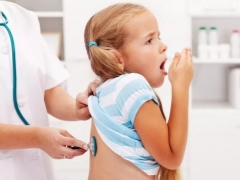Symptoms and treatment of true croup in children
There are such diseases that pose a certain danger to life, but they are dangerous only in childhood. One of these ailments is croup. After reading this article, you will learn what a true croup is, how to distinguish it from a false croup, what are the symptoms and treatment.
What it is?
Croup in children is a disease of the respiratory system. When it in the respiratory organs develops an inflammatory process, which is complicated by stenosis (narrowing) of the larynx. Fertile ground for the development of croup is any infectious disease of the respiratory system - both acute and chronic. At risk - children from 3 months to 3 years. At this age, the airways are already narrow, so any inflammation can cause stenosis.
False croup usually develops with acute respiratory viral infections. A rather extensive area of the respiratory system suffers because of it - inflammation passes to the area of the vocal cords, the trachea and the bronchi.
For true croup, only the vocal cords suffer. Usually, true croup develops against the background of falling into the region of the vocal cords of a foreign small object or particles of pus, dead epithelium during inflammation in the upper respiratory tract.
Viral croup usually does not lead to death from asphyxiation, because it has an amazing ability to self-regulate. However, other types of the disease are not so harmless.
True croup is also called diphtheria, because it is this complication that most often occurs with this infection. At the same time, the glottis is not only narrowed, but also covered by diphtheria.
Symptoms
Symptoms of true croup usually develop (as well as signs of false croup) on the second or third day after the onset of the underlying disease. The first (and most obvious) signs are barking cough, hoarseness. The region of the vocal cords is the bottleneck of the child’s respiratory system. The inflammatory process in this area can not go unnoticed.
Against the background of high temperature, stenosis of the larynx can cause difficulty breathing, as well as characteristic wheezing, which can be heard in minutes when the child cries, and sometimes even in a calm state.
Such signs as abundant and incessant drooling, severe shortness of breath, blue skin in the area of the nasolabial triangle indicate deterioration of the child’s condition.
In the second or third stages of the croup, the child can inhale a much smaller amount of air than in the zero or first stage, there may be asthma attacks, loss of consciousness, oxygen starvation of the brain.
With true croup, the child’s condition will vary in stages.because the disease itself develops in strict accordance with certain stages. After the acute stage stenotic occurs. If the child has not been assisted, this stage becomes asfixed.
Dyspnea with developing true croup has a special character - a very difficult inhale and an almost uncomplicated exhalation.
When diphtheria croup in a child most often observed fever, high fever, severe intoxication. A special diphtheria bloom appears in the throat, similar to a grayish tight and dense film. They also covered tonsils.
Even if a viral or allergic mock croup begins with the same symptoms, on the second day there will be significant differences in condition. With true croup, there will be no night attacks and sudden sharp breathing difficulties.In any case, until it develops to the asphyxial stage.
The defeat of the vocal cords with true croup progresses up to the complete loss of the ability to speak. In this case, the child begins to cry and cough completely silently. He can't even shout. With a false croup, such a symptom never happens. The voice becomes hoarse, but does not completely disappear.
All symptoms in a child develop much faster than in an adult. Sometimes they proceed very rapidly, and in no case should I delay in referring to a doctor.
Diagnostics
The pediatrician, together with the ENT specialist and the infectious disease specialist, is dealing with the diagnosis if it is a question of true croup. Radiography of the larynx can tell a lot to specialists. By the degree of narrowing, doctors will be able to judge the stage of the disease. If there are foreign objects in the throat, this can also be immediately determined by x-ray. The leading sign of the disease is the narrowing of the larynx, which in the picture has a wedge-like appearance.
To clarify the diagnosis is assigned laryngoscopy. With true croup, it shows significant changes in the mucous membranes of the vocal cords and larynx, as well as the presence of diphtheria membranous plaque.
However, to establish the diagnosis with one hundred percent accuracy allows bacteriological examination of the pharyngeal swab. If a diphtheria bacillus is detected in it, the doctor will not hesitate with the formulation of the diagnosis “true croup”.
If you suspect diphtheria, children are usually immediately hospitalized, so all the above diagnostic activities of the child will take place in the hospital.
The reasons
True croup is not allergic. This is what distinguishes it from spastic croup (extremely dangerous and poorly understood diseases), as well as from the rather common false croup. The main reason for the emergence of true croup lies in diphtheria stickwhich causes such an unpleasant disease as diphtheria.
Doctors can detect in a child with true croup a foreign body in the region of the vocal folds, in the narrowest part of the respiratory system.
Treatment
True croup at home is not treated, it is too dangerous a disease that can lead to suffocation. All children with this diagnosis should be hospitalized in an infectious diseases hospital.
For the treatment of the disease, anti-diphtheria serum obtained from the blood of horses, which have been hypersensitized with diphtheria bacillus, is used. Serum can cause a severe allergic reaction, which is why the child should be under constant medical supervision.
In case of marked difficulty in breathing, “Prednisolone»Intravenously (in droppers). In addition, they carry out drip infusions of solutions that reduce the level of intoxication and poisoning with waste products of diphtheria bacilli, the most dangerous of which is exotoxin.
For the throat in parallel with the introduction of serum prescribe some antiseptics. When attaching a bacterial infection, penicillin antibiotics or antimicrobials of the cephalosporins group are prescribed.
If it is impossible to breathe, a tracheostomy is performed independently - dissection of the trachea to create a backup path for the air that enters the lungs.
Complications
Such a dangerous syndrome quite often gives complications, even if medical assistance was provided correctly and in a timely manner. Such complications include pneumonia, otitis media, meningitis.
Failure to help or ignore the symptoms of croup can be fatal due to suffocation.
First aid
The transition from the catarrhal stage of true croup to the loss of voice often causes panic in children, because they cannot say something (and they even cannot cry).Therefore, after calling an ambulance, it is important to calm the child down, set him up for good. The extra worries and experiences only increase the need for a deep breath, and it is impossible to do it at the stenotic stage.
It is necessary to ensure peace, put the child in a horizontal position.
It is recommended to open all the windows in the house, if it is cold outside - you need to dress the child warmer. Fresh air is needed.
A warm drink should be given to the child before the arrival of the doctors. If he feels sick, it is difficult for him to swallow, he can be dripped from a disposable syringe without a needle or from a teaspoon (in small portions).
Do not give the child any medication. Neither anti-cough drugs nor antibiotics can help in the case of diphtheria croup. Requires the introduction of a special serum, this is what awaits a child in a hospital. In case of marked difficulty in breathing, an antihistamine can be given in the age dosage - for example, “Suprastin”. It will temporarily reduce the swelling and allow wait for the arrival of health workers.
Prevention
Prevention of true croup is closely related to the prevention of diphtheria. From this dangerous disease, mandatory vaccinations are given to all children.
Vaccination does not provide one hundred percent protection, but children who have been vaccinated, in case of infection, suffer from diphtheria in a milder degree. The development of true croup usually does not reach.
Parents should not refuse vaccines such as ADX or ADS, since these vaccines contain a diphtheria component. The first vaccination is usually provided for infants at the age of 3 months. Then two vaccinations are done at intervals of 2 months. The fourth - a year after the third. Revaccination - at 6 and 14 years.
Adults need to carefully monitor that the child does not play with small objects that he can inhale. They may remain in the crease next to the vocal cords.
At the first signs of hoarseness and shortness of breath, you should call an ambulance.without waiting for the other symptoms of true croup. By telephone, the dispatcher should definitely report his suspicions about true croup, this will significantly speed up the arrival of a medical team with special equipment that will allow them to deliver the child to the hospital alive.
About what is croup and how to treat it, see the next video.

































